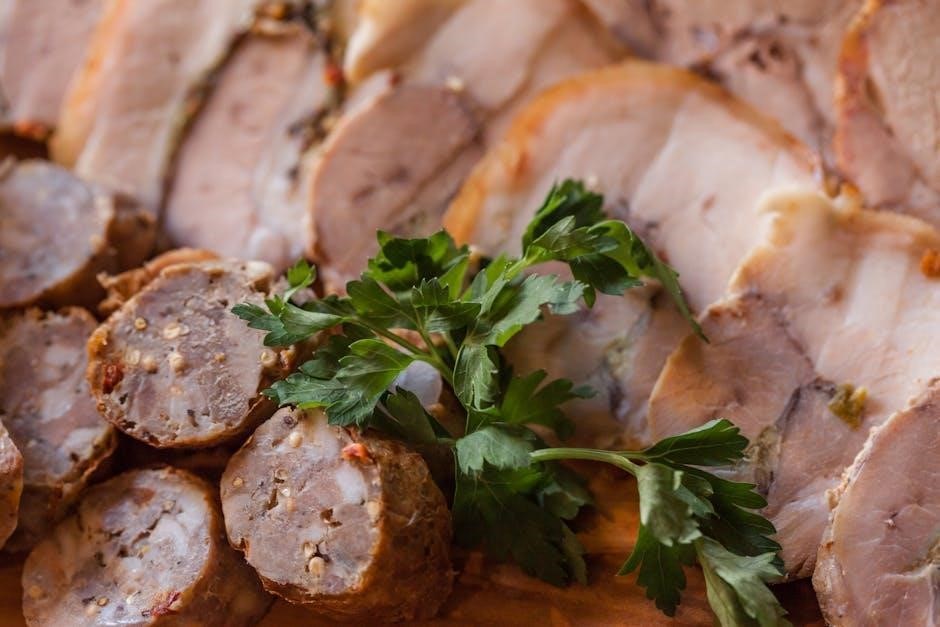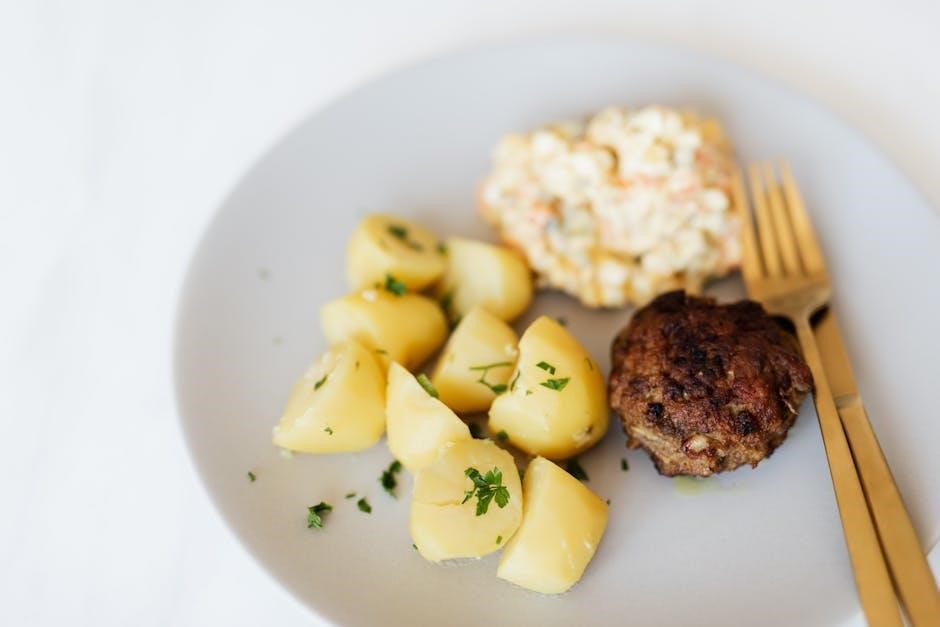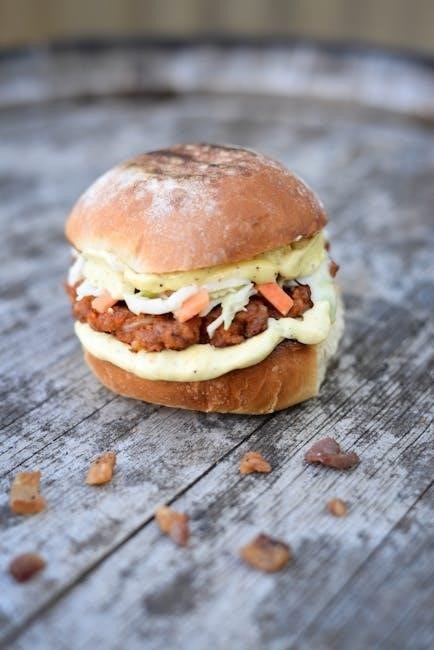A structured 1600-calorie high-protein meal plan designed for weight loss and muscle maintenance‚ offering balanced meals and snacks to keep you energized and focused throughout the day.
Overview of the 1600 Calorie Meal Plan
This meal plan is designed to provide a balanced intake of 1600 calories daily‚ focusing on high protein to support weight loss and muscle maintenance. Each day includes breakfast‚ lunch‚ dinner‚ and 2-3 snacks‚ ensuring a variety of nutrient-rich foods; The plan emphasizes lean proteins‚ whole grains‚ and vegetables‚ while keeping fats and carbs in check. With options for both animal and plant-based sources‚ it caters to diverse dietary preferences. The structured approach helps maintain energy levels and satisfies hunger‚ making it sustainable for long-term use.
Importance of High Protein in a 1600 Calorie Diet
High protein is essential in a 1600-calorie diet for preserving muscle mass and boosting metabolism. It helps maintain satiety‚ reducing hunger and cravings‚ which supports weight loss. Protein also aids in hormone production and overall bodily functions. By incorporating lean proteins‚ the diet ensures efficient nutrient utilization‚ making the calorie-restricted plan more sustainable and effective for health and fitness goals.

Why Choose a 1600 Calorie High Protein Meal Plan?
A 1600-calorie high-protein meal plan is ideal for weight loss‚ muscle maintenance‚ and improved overall health‚ offering balanced nutrition and sustained energy throughout the day.
Weight Loss and Calorie Deficit
A 1600-calorie meal plan creates a calorie deficit‚ essential for weight loss. High protein helps maintain muscle mass‚ boosting metabolism and fat burning. Balanced meals keep energy levels steady‚ reducing hunger and cravings. This structured approach ensures sustainable weight loss while preserving lean tissue and overall health. It supports fat reduction without sacrificing muscle‚ making it ideal for those seeking a leaner‚ healthier physique. Consistency is key to achieving and maintaining weight loss goals effectively.
Muscle Maintenance and Growth
High protein intake is crucial for muscle maintenance and growth‚ even on a 1600-calorie diet. Adequate protein ensures muscle repair and recovery‚ preventing muscle loss during weight loss. Lean proteins like chicken‚ fish‚ and eggs support muscle synthesis‚ while balanced meals provide essential amino acids. This plan helps maintain muscle mass‚ supporting fitness goals and overall health. Consistent protein intake keeps muscles strong and active‚ making it ideal for those aiming to tone or maintain muscle while managing weight effectively.
Improved Overall Health and Energy
A 1600-calorie high-protein meal plan promotes improved overall health and sustained energy levels. High-quality proteins support muscle function‚ immune health‚ and mental clarity. Balanced meals with lean proteins‚ healthy fats‚ and complex carbs provide steady energy‚ reducing fatigue. This plan ensures nutrient-dense foods‚ including fish‚ eggs‚ and legumes‚ support long-term health and vitality. By prioritizing protein and balanced nutrition‚ it helps maintain energy levels throughout the day while supporting overall well-being and bodily functions effectively.
Benefits of a High Protein Diet
A high-protein diet increases satiety‚ boosts metabolism‚ and supports blood sugar control‚ helping maintain energy levels and overall health while promoting a balanced nutrient intake.
Increased Satiety and Reduced Hunger
A high-protein diet helps increase satiety‚ reducing hunger and cravings throughout the day. Protein takes longer to digest than carbohydrates‚ keeping you fuller for extended periods. Meals rich in lean proteins like chicken‚ fish‚ eggs‚ tofu‚ and legumes promote a feeling of satisfaction‚ making it easier to stick to the 1600-calorie plan. This reduced hunger supports weight loss by naturally controlling calorie intake and preventing overeating. Incorporating protein-rich snacks‚ such as Greek yogurt or cottage cheese‚ further enhances this benefit.
Enhanced Metabolism
A high-protein diet boosts metabolism by increasing the thermic effect of food (TEF)‚ requiring more energy to digest protein compared to carbohydrates or fats. This heightened metabolic activity helps burn more calories‚ even at rest‚ supporting fat loss and energy expenditure. Protein-rich meals also preserve lean muscle mass‚ further enhancing metabolic rate. By incorporating lean proteins like chicken‚ fish‚ and legumes‚ the 1600-calorie meal plan accelerates metabolism‚ aiding in sustainable weight loss and improved overall health.
Better Blood Sugar Control
A high-protein diet helps regulate blood sugar levels by slowing digestion and preventing rapid spikes in insulin levels. Protein-rich foods like lean meats‚ fish‚ and legumes promote insulin sensitivity and stabilize glucose metabolism. Balanced meals with protein‚ complex carbs‚ and healthy fats maintain steady energy levels‚ reducing cravings and supporting long-term blood sugar management. This approach is particularly beneficial for improving metabolic health and managing weight effectively while keeping blood sugar fluctuations under control.
How to Create a 1600 Calorie High Protein Meal Plan
Start by calculating protein needs‚ balancing macronutrients‚ and planning meals with lean proteins‚ whole grains‚ and vegetables to meet calorie and protein goals effectively.
Understanding Macronutrient Balance
A 1600-calorie high-protein meal plan requires balancing macronutrients: protein‚ carbohydrates‚ and fats. Protein should be prioritized (around 100-120g daily) to support muscle maintenance and satiety. Carbohydrates‚ ideally complex ones like whole grains and vegetables‚ provide energy‚ while healthy fats (e.g.‚ avocado‚ nuts) support hormone production. Aim for a distribution of 40% protein‚ 35% carbs‚ and 25% fats. This balance ensures sustained energy‚ aids weight loss‚ and promotes overall health. Vary protein sources and pair with fiber-rich foods for optimal results.
Calculating Protein Needs
Calculating protein needs is crucial for a 1600-calorie high-protein meal plan. Generally‚ 100-120g of protein per day is recommended for weight loss and muscle maintenance. This translates to 20-30g of protein per meal and 10-15g per snack. Protein needs vary based on weight‚ activity level‚ and goals. For example‚ a 65kg individual might aim for 1.6g of protein per kilogram of body weight. Adjust intake to meet specific goals‚ ensuring meals are balanced and nutrient-dense to support overall health and energy levels throughout the day.
Meal Frequency and Timing
A 1600-calorie high-protein meal plan typically includes 3 main meals and 2-3 snacks daily. Spacing protein intake evenly across meals helps maintain muscle synthesis and satisfaction. Aim for balanced protein portions at breakfast‚ lunch‚ and dinner‚ with snacks providing additional boosts. Timing meals every 3-4 hours supports metabolism and prevents hunger spikes. Ensure each meal aligns with your calorie and protein goals‚ avoiding excessive intake while keeping meals nutrient-dense and satisfying.
Sample 7-Day 1600 Calorie High Protein Meal Plan
A 7-day structured meal plan with balanced high-protein meals and snacks‚ ensuring daily calorie and protein targets are met with nutrient-rich‚ varied food choices;
Day 1: Sample Meals and Snacks
Start with breakfast: oatmeal with protein powder‚ almond butter‚ and berries. Mid-morning‚ snack on Greek yogurt with mixed berries. For lunch‚ enjoy grilled chicken breast with quinoa and steamed vegetables. A protein shake with almond milk serves as an afternoon snack. Dinner features baked salmon‚ sweet potato‚ and broccoli. This balanced plan ensures high protein intake‚ staying within the 1600-calorie target‚ and provides sustained energy throughout the day with nutrient-dense meals and snacks.
Day 2: Balanced Protein Intake
Begin Day 2 with a high-protein breakfast of scrambled eggs with spinach and whole-grain toast. A mid-morning snack of cottage cheese and pineapple boosts protein levels. For lunch‚ opt for turkey breast with brown rice and mixed greens. An afternoon snack includes hard-boiled eggs and carrot sticks. Dinner features grilled shrimp‚ asparagus‚ and quinoa. This balanced intake ensures steady protein consumption‚ maintaining muscle health and energy levels while adhering to the 1600-calorie goal.
Day 3: Incorporating Lean Proteins
Day 3 focuses on lean proteins to support muscle health and calorie goals. Start with Greek yogurt topped with berries and almonds for breakfast. Lunch features grilled chicken breast paired with quinoa and steamed vegetables. A mid-afternoon snack of hard-boiled eggs and cherry tomatoes maintains protein levels. For dinner‚ enjoy baked cod with roasted asparagus and sweet potatoes. This balanced intake ensures sustained energy and muscle maintenance while staying within the 1600-calorie framework. Staying hydrated with water supports overall metabolism and digestion.
Day 4: Fish and Egg-Based Meals
Begin with scrambled eggs and spinach‚ served with whole-grain toast for a protein-rich breakfast. Lunch features grilled salmon alongside brown rice and steamed broccoli. A mid-afternoon snack of cottage cheese with sliced peaches provides sustained protein. For dinner‚ enjoy shrimp stir-fry with zucchini noodles and a side salad. This day emphasizes fish and eggs as lean protein sources‚ ensuring a balance of nutrients while maintaining the 1600-calorie goal. Staying hydrated with water supports digestion and overall health throughout the day.
Day 5: Legume and Grain Combinations
Start with lentil and quinoa breakfast bowl‚ topped with avocado and a sprinkle of chia seeds. Lunch includes chickpea and brown rice salad‚ mixed with roasted vegetables and a lemon-tahini dressing. For a snack‚ enjoy edamame with sea salt. Dinner features black bean and wild rice stir-fry with bell peppers and a side of steamed green beans. This day combines plant-based proteins with whole grains for sustained energy and nutrient-rich meals‚ staying within the 1600-calorie target.
Day 6: High Protein Snacks
Begin with Greek yogurt with berries and almonds for breakfast. Mid-morning‚ enjoy hard-boiled eggs and cherry tomatoes. Lunch features grilled chicken wrap with mixed greens in a low-calorie tortilla. Mid-afternoon‚ snack on cottage cheese with pineapple chunks. Dinner includes baked salmon with quinoa and steamed broccoli. End the day with a protein shake mixed with almond milk and spinach. These snacks boost protein intake while keeping calories balanced‚ ensuring sustained energy throughout the day within the 1600-calorie plan.
Day 7: Vegetarian High Protein Options
Start with chia pudding topped with fresh berries and walnuts for breakfast. Mid-morning‚ enjoy edamame and sliced cucumber. Lunch features quinoa salad with chickpeas‚ spinach‚ and a lemon-tahini dressing. Mid-afternoon‚ snack on hummus with veggie sticks. Dinner includes lentil soup with a side of steamed green beans. End the day with unsweetened almond milk with a scoop of plant-based protein powder‚ ensuring a balanced and protein-rich vegetarian meal plan within 1600 calories.

Key Foods for a High Protein Diet
Emphasize lean meats‚ fish‚ eggs‚ dairy‚ legumes‚ and nuts as high-protein essentials‚ supporting muscle growth and overall health in a balanced 1600-calorie diet.
Animal-Based Protein Sources
Animal-based proteins like lean meats‚ fish‚ eggs‚ and dairy are rich in essential amino acids. Opt for chicken breast‚ turkey‚ salmon‚ tilapia‚ eggs‚ Greek yogurt‚ and cottage cheese. These options provide high-quality protein to support muscle growth and overall health. Include a variety of these in your meals to ensure a broad nutrient intake. Portion control is key to maintaining the 1600-calorie target. Aim for 3-4 ounces of meat or fish and 2 large eggs or a half-cup of Greek yogurt per serving.
Plant-Based Protein Sources
Plant-based proteins are a nutritious and versatile option for a high-protein diet. Include beans (e.g.‚ black beans‚ chickpeas)‚ lentils‚ tofu‚ tempeh‚ edamame‚ and quinoa. These foods are rich in protein and fiber‚ making them filling and nutritious. Aim for 3-4 servings daily‚ with each serving providing 15-20 grams of protein. Incorporate them into salads‚ stir-fries‚ or as protein substitutes in meals to meet your daily protein goals without exceeding calorie limits. They are also low in saturated fat and rich in essential nutrients.
Dairy and Egg Options
Dairy and eggs are excellent sources of high-quality protein‚ essential for muscle repair and growth. Choose low-fat options like Greek yogurt‚ cottage cheese‚ and milk to keep calories in check. Eggs are a versatile and protein-rich addition to meals‚ with about 6 grams of protein per egg. Incorporate these into breakfast‚ snacks‚ or dinners to boost protein intake without exceeding calorie limits. They also provide essential nutrients like calcium and vitamins‚ making them a nutritious addition to your meal plan.
Tips for Sticking to the Meal Plan
Plan meals in advance‚ prep ingredients‚ and stay hydrated. Incorporate physical activity to support weight loss and muscle maintenance‚ ensuring consistency and adherence to the plan.
Meal Prepping and Organization
Meal prepping is essential for staying on track with your 1600-calorie high-protein diet. Plan your meals for the week‚ shop for ingredients‚ and portion them in containers. This saves time‚ reduces food waste‚ and ensures every meal aligns with your calorie and protein goals. Use a printable PDF meal plan to organize breakfast‚ lunch‚ dinner‚ and snacks. Staying organized helps maintain consistency and makes healthy eating easier‚ even on busy days.
Staying Hydrated
Staying hydrated is crucial for overall health and can aid in weight loss and muscle maintenance. Drinking water before meals helps with portion control and can boost metabolism. Incorporate herbal teas and low-calorie drinks to variety your intake. Limit sugary beverages to avoid extra calories. Monitoring your water intake and setting reminders can help you stay on track. A printable PDF meal plan can include space to track hydration‚ ensuring you meet your daily goals for optimal health and performance.
Incorporating Physical Activity
Incorporating physical activity into your 1600-calorie high-protein meal plan enhances weight loss and muscle maintenance. Aim for a mix of cardio and strength training to boost metabolism and build lean muscle. Regular exercise complements the calorie deficit‚ ensuring sustainable results. Use the printable PDF to track workouts alongside meals for a balanced routine. Staying active supports overall health and energy levels‚ making it easier to stick to your dietary goals. Consistency is key to achieving long-term success with your high-protein meal plan.

Common Mistakes to Avoid
- Overconsumption of calories‚ exceeding the 1600 target.
- Ignoring fiber intake‚ leading to poor digestion.
- Not varying protein sources‚ risking nutrient deficiencies.
- Neglecting hydration‚ essential for metabolism and health.
Overconsumption of Calories
Exceeding the 1600-calorie limit can hinder weight loss and muscle maintenance goals. Even high-protein meals‚ if overeaten‚ lead to calorie surplus. Be mindful of portion sizes and avoid adding extra calories through sauces or snacks. Track meals to ensure adherence to the plan. Small deviations can accumulate‚ derailing progress. Stay disciplined to maximize the benefits of this structured diet.
Ignoring Fiber Intake
Overlooking fiber in a high-protein diet can lead to digestive discomfort and constipation. Fiber aids in satiety and blood sugar regulation‚ complementing weight loss efforts. A low-fiber diet may result in feeling unsatisfied‚ potentially leading to overeating. Incorporate high-fiber foods like vegetables‚ whole grains‚ and legumes to maintain a balanced diet. Ensure each meal includes a mix of protein‚ healthy fats‚ and fiber-rich carbohydrates to support overall health and digestion while adhering to the 1600-calorie plan.
Not Varying Protein Sources
Reliance on a single protein source can limit essential nutrients and lead to imbalances. Incorporate diverse options like lean meats‚ fish‚ eggs‚ legumes‚ and whole grains to ensure a broad amino acid profile. This variety supports overall health and keeps meals interesting‚ preventing boredom and nutritional deficiencies. A well-rounded approach enhances the effectiveness of the 1600-calorie high-protein plan‚ promoting sustained energy and muscle maintenance while maintaining dietary interest and satisfaction.

Frequently Asked Questions
Common inquiries include whether 1600 calories provide enough energy‚ if high protein aids muscle growth‚ and how to adapt the plan for vegetarian diets effectively.
Will I Feel Hungry on 1600 Calories?
Feeling hungry on a 1600-calorie diet depends on individual factors like metabolism‚ activity level‚ and meal composition. High-protein meals tend to increase satiety‚ reducing hunger. Including fiber-rich vegetables and healthy fats in meals can also help keep you fuller longer. Staying hydrated and maintaining consistent meal timing can further suppress hunger pangs. If hunger persists‚ adjusting portion sizes or calorie intake slightly may be necessary to ensure the plan suits your needs effectively.
Can I Gain Muscle on This Plan?
Gaining muscle on a 1600-calorie high-protein diet is possible but may require careful planning. The high protein intake supports muscle repair and growth‚ while the calorie deficit aids weight loss. However‚ muscle gain typically requires a calorie surplus‚ so results may vary. Combining the meal plan with resistance training and ensuring adequate protein intake (1.2-1.6g per kg of body weight) can help maintain or even build muscle mass. Adjustments may be needed based on individual progress and goals.
How to Adjust for Vegetarian Needs
For vegetarians‚ the 1600-calorie high-protein meal plan can be adapted by focusing on plant-based protein sources like legumes‚ beans‚ tofu‚ and quinoa. Include dairy and eggs for additional protein. Swap meat-based meals with options like lentil stir-fries or chickpea salads. Ensure variety by incorporating a mix of whole grains‚ nuts‚ and seeds. Meal prepping with protein-rich snacks like Greek yogurt or edamame can help meet daily protein goals. Customize the meal plan to suit vegetarian preferences while maintaining calorie and protein balance.

Downloading the 1600 Calorie Meal Plan PDF
Download the 1600-calorie high-protein meal plan PDF for a structured approach to weight loss and muscle maintenance. Get printable meal plans with balanced nutrition and customization options.
Features of the PDF Plan
The PDF plan offers a comprehensive 7-day meal schedule with high-protein recipes‚ macronutrient breakdowns‚ and customizable options. It includes breakfast‚ lunch‚ dinner‚ and snacks‚ ensuring balanced nutrition. Each day’s meals are carefully portioned to meet the 1600-calorie target‚ with a focus on lean proteins‚ whole grains‚ and vegetables. The plan also provides grocery lists and tips for meal prep‚ making it easy to follow and adapt to individual needs. It’s designed to support weight loss and muscle maintenance effectively.
How to Customize the Plan
Easily tailor the 1600-calorie high-protein meal plan to suit your preferences and dietary needs. Adjust portion sizes based on individual calorie requirements and protein goals. Swap out ingredients with similar alternatives to keep meals exciting and personalized. For vegetarians‚ replace animal-based proteins with plant-based options like legumes or tofu. Customize macronutrient ratios to align with specific fitness or health objectives‚ ensuring the plan remains balanced and nutritious while meeting your unique lifestyle demands.
Benefits of a Printable Meal Plan
A printable 1600-calorie high-protein meal plan offers convenience and clarity. It provides a structured guide‚ making it easier to stay organized and committed to your dietary goals. Having a physical copy allows for better meal tracking and grocery planning. The clear layout ensures all nutritional requirements are met‚ helping you maintain consistency and motivation. Plus‚ it serves as a handy reference for quick meal prep decisions‚ keeping you on track without constant digital checks.
A 1600-calorie high-protein meal plan offers a balanced approach to weight loss and muscle maintenance. Stay committed‚ and you’ll see results in weight management and overall health.
Final Thoughts on the 1600 Calorie High Protein Diet
The 1600-calorie high-protein meal plan is a well-rounded approach to weight loss and muscle maintenance‚ offering balanced nutrition and flexibility. By focusing on lean proteins‚ whole foods‚ and controlled portions‚ this plan supports fat loss while preserving muscle mass. It’s ideal for those seeking a structured yet customizable diet. Consistency and proper hydration are key to success. Always consult a healthcare provider before starting any new diet to ensure it meets your specific needs and goals.
Next Steps for Success
Start by downloading the printable PDF meal plan to organize your daily meals. Track your progress‚ including weight‚ measurements‚ and energy levels. Meal prep in advance to stay consistent and avoid temptations. Incorporate regular physical activity‚ such as strength training and cardio‚ to enhance results. Stay hydrated by drinking plenty of water throughout the day. Adjust portion sizes or protein sources as needed to suit your preferences or dietary restrictions. Celebrate small victories and stay committed to your goals for long-term success.